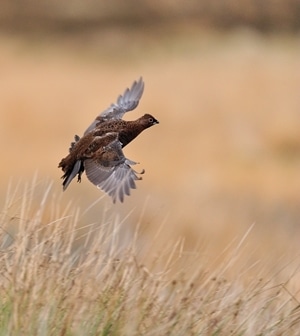As the the Glorious 12th August approaches, we take a look at The King of Game Birds, The Red Grouse.
The red grouse is a bird of heather moorland with a range restricted to areas of blanket bog and upland shrub heath. It is a subspecies of the willow grouse (L. l. lagopus), whose range extends across the northern latitudes of Europe, Asia and North America. The red grouse differs by not developing white plumage during winter and having a diet almost exclusively of heather.
 Reg Grouse flying
Reg Grouse flying
Since the mid-1800s, many areas of heather have been managed to produce grouse for shooting. Indeed, grouse shooting has been one of the major land uses of upland ground and an important source of income for many estates.
"Old grouse are not fit for cooking till the feathers pull very loosely from the "apron". When "high", put a piece of bread inside them while roasting; take out the bread before dishing, and throw it away."
We estimate that the numbers of grouse shot per year between 1911 and 1980 has fallen by 82%. Particularly severe long-term declines occurred after the Second World War and after the mid-1970s in Scotland and Wales. In recent history, grouse numbers have remained stable on many English moors, although 2011 and 2012 counts by the Trust recorded record years since our counting began despite the poor weather in 2012. We put these recent successes down to the new form of medicated grit developed by our research. Spring densities in Scotland were similar to 2011 and grouse generally bred well despite the poor weather of 2012 but grouse densities were down 9% on 2011.
The Cookery Book of Lady Clark of Tillypronie (1909) has 11 recipes for using Grouse. The recipe "To cook old birds" runs as follows:
Old grouse are not fit for cooking till the feathers pull very loosely from the "apron". When "high", put a piece of bread inside them while roasting; take out the bread before dishing, and throw it away. A good gravy should be served with them in a boat, none in the dish, but put the birds on a toast when bread is plentiful.—Lady Clark of Tillypronie
Shooting can take the form of 'walked up' (where shooters walk across the moor to flush grouse and take a shot) or 'driven' (where grouse are driven, often in large numbers, by 'beaters' towards the guns who are hiding behind a line of 'butts'). Many moors are managed to increase the density of grouse. Areas of heather are subjected to controlled burning; this allows fresh young shoots to regenerate, which are favoured by the grouse. Extensive predator control is a feature of grouse moor management: foxes, stoats and crows are usually heavily controlled on grouse moors. The extent to which it occurs on grouse moors is hotly contested between conservation groups and shooting interests, and the subject generates a lot of media attention in relation to grouse moors and shooting.